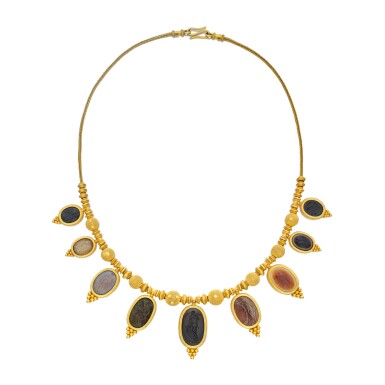Important Jewels
Important Jewels

Property of a Private Collector
Gold and Hardstone Necklace
Lot closes
September 20, 03:00 PM GMT
Estimate
8,000 - 12,000 USD
Starting Bid
5,500 USD
Lot Details
Description
Designed in the Etruscan revival style, applied with bead and rope twist details, the front threaded with fluted beads supporting a fringe of graduated collet-set intaglios of chalcedony, onyx and sardonyx depicting various Greco-Roman figures, spaced with granulated gold beads and rondelles, to a spiga-link chain necklace.
- Length 21¼ inches
- 22 karat gold
- Circa 1870
- Gross weight approximately 71 dwts
For a similar unsigned necklace by Giacinto Melillo, see Castellani and Italian Archaeological Jewelry by Susan Weber Soros and Stefanie Walker, Editors, Fig. 12-26, page 328.
Giacinto Melillo (1848-1915) is considered one of the most talented nineteenth-century goldsmiths working in the Archaeological revival style. Little is known about his early life, but he trained under Alessandro Castellani (1823-1883) in his Naples workshop and took over the premises in 1870 to make jewelry under his own name at the age of just 24. Melillo exhibited at numerous international exhibitions throughout his career and was awarded many silver and gold medals, culminating with the Grand Prix at the 1900 Paris Exposition Universelle and his induction into the Légion d’Honneur.
The nineteenth century witnessed a growing fascination with Etruscan, Greek and Roman goldwork. The ancient jewelry collection of banker Giampietro Campana (1808-1880) sparked great admiration and attracted many visitors to his Roman villa before his financial disgrace led to its sale to France in 1861 and its relocation to the Louvre. Leading up to this sale the Campana Collection was temporarily held by the Castellani family while the jewelers tried to locate a buyer who might allow the pieces to remain in Rome. Brothers Alessandro and Augusto Castellani (1829-1914) studied the jewels assiduously and began attempting to rediscover the techniques that enabled ancient goldsmiths to create fine and intricate wirework and granulation. It is believed that Alessandro may have worked closely with Giacinto Melillo to develop and perfect his copies of ancient goldwork, and Melillo continued to produce jewelry using these techniques after he began to work independently. Although the true technical secret to Etruscan granulation was not discovered until the 1930s, Melillo’s jewels come very close to matching the delicacy of original ancient examples.
Lot 59 is based on jewels from the Campana Collection that are sometimes referred to as “Campana bracelets.” Composed of multiple ornate plaques, the bracelets are now believed to have been constructed from the remnants of several ancient Etruscan earrings. Melillo and the Castellanis created several examples of these bracelets, using each plaque to showcase a different motif. This example is enlivened by colorful enamel and comes with its original signed fitted wooden box.
Lot 60 is unsigned and cannot be definitively attributed to Giacinto Melillo, but it is very similar to extant examples of Melillo necklaces in its design and construction techniques. Melillo did not sign the majority of his goldwork, and the loss of original boxes can make it difficult to determine whether a piece was made by the jeweler.
You May Also Like










